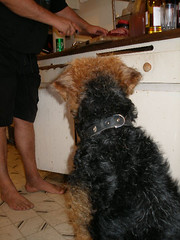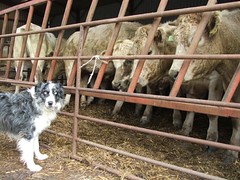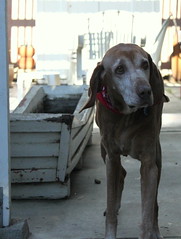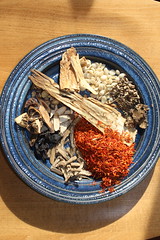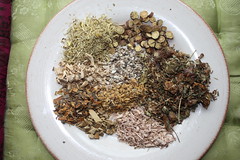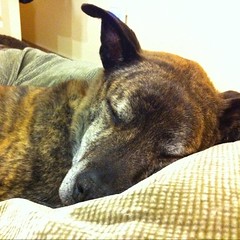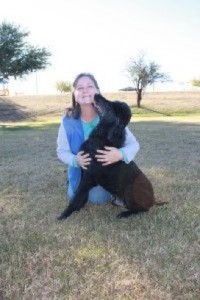Three legged and happy – how to holistically treat osteosarcoma (bone cancer) in dogs
May 8th, 2011When I was studying with my acupuncture teacher, Richard Panzer, I met an incredible great dane with osteosarcoma. She was fairly young and her prognosis was not good. However she would bounce into the clinic twice a week for acupuncture treatments, full of life. Her tumor slowly became larger but the cancer did not spread to her lungs, which is typical of this disease. Eventually when she became extremely painful they made the decision to amputate her effected leg. I heard that she later died of a disease unrelated to her bone cancer.
The first dog I treated with osteosarcoma, Maggie, had a similar story. She went a year before her bone was so weakened from the cancer that it broke and her leg had to be amputated in an emergency surgery. She is still alive over five years later. Here is her full story, Maggie’s story – Sometimes three legs are better than four.
Osteosarcoma or bone cancer is one of the most painful cancers out there but it is also the one I have had the most success with using integrative and alternative treatments.
In all the dogs I have treated, I see about 70% of them bet the cancer.. Most dogs die of something else. However, if amputation is not an option, pain becomes the factor that causes their human companions to put them to sleep. Even the strongest pain medications can not control the pain of osteosarcoma.
With no treatment, most dogs with osteosarcoma will live three months after diagnosis and die from lung metastases, the cancer spreading to the lungs. However herbal medicine has some amazing tools to keep cancer out of the lungs and make it so dogs can live with osteosarcoma and sometimes go into complete remissions if we can amputate the primary tumor.
I’m seeing more and more pet parents use an integrative approach – doing 3-6 chemo treats with holistic medicine. There are also some immunotherapy treatments. I recommend checking in with an oncologist.
So what is my protocol for osteosarcoma?

- Amputation – Above all I recommend amputation if it is at all possible. This is a very painful cancer. The only way to get rid of the pain is to amputate. There is no way to get rid of the primary tumor without amputation even with chemo and radiation therapy. This is the most important treatment, in my opinion. I know it seems like a major and harsh option, but most of these dogs immediately feel better from amputation. I think we do not realize how much pain they have been in before we amputate. Pain medication can not adequately control the pain of osteosarcoma.
- A cancer diet – this means a high protein diet with no grains. Ideally it should be cooked or canned. Raw is also ok if your dog will tolerate it and is not getting chemo. Don’t give this cancer the fuel it needs. Please see the article Diets for cancer in cats and dogs.
- Artemisinin. – Follow this link for more information about the supplement and how it is given. Artemisinin is under study at the University of Washington for its effect against bone cancer in people. Do not use artemisinin if your animal is getting radiation.
- Sanshedan Chuanbeiye – This is my number one herbal for keeping cancer out of the lungs. Follow this link for more information about this herbal.
- Acupuncture – I recommend weekly or every other week acupuncture depending on the stage of illness. Acupuncture can slow down this disease, boost the immune system and help with pain. To find a veterinary acupuncturist in your area use this tool IVAS find an acupuncturist.
In addition I sometimes use the following
- Hoxsey like formula or Cancer Detox Support – if your dog is very hot with a lot of panting and heat intolerance or if amputation is not possible I recommend adding in this formula. If the primary tumor remains then boneset should be added to this formula to treat bone pain.
- Mushrooms can help to boost your dog’s immune system and support them during treatment.
- Pain medication, if amputation is not possible. This is a very painful cancer. If the primary tumor remains western pain medication is a must. Most dogs should be on a NSAID such as Rimadyl, Tramadol and possibly Gabapentin.
- Radiation treatments, if amputation is not possible. Radiation treatments can help with the pain of osteosarcoma. I highly recommend talking to an oncologist about this option if amputation is not possible. If your animal is getting radiation do not give artemisinin. Milk thistle can help to enhance the effects of radiation and decrease the side effects.
If there is radiographic evidence of lung metastasis please also see the article Breathing through cancer – holistic therapies to control lung metastasis in cancer
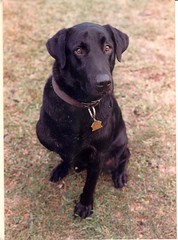 I have known quite a few very happy three legged dogs. Dogs are great at just taking life one day at a time. I believe that this is a treatable cancer. Every dog will follow their own path, however I have been amazed at how well this herbal and acupuncture protocol can work.
I have known quite a few very happy three legged dogs. Dogs are great at just taking life one day at a time. I believe that this is a treatable cancer. Every dog will follow their own path, however I have been amazed at how well this herbal and acupuncture protocol can work.
Even though I have had a lot of success in treating this cancer, I recommend that you consult with an oncologist to make sure you know all your options. If possible find a good holistic vet in your area to help create a herbal program for your dog and do acupuncture treatments. If they are trained in acupuncture but not herbal medicine bring them this article.
As with all articles on this blog, please consult with your animal’s primary veterinarian about coming up with a protocol for your dog or cat and before using these products. Every dog is individual and there may be a better protocol for your dog then what I suggest based on their personal medical history and constitution.
Some cancers are more aggressive than others and even though I have had a lot of success with treating osteosarcoma, this protocol may not work for everyone.
Very rarely this cancer occurs in cats. While this article is written for dogs, I have used these herbals in cats as well.
Return to Integrative and Holistic Methods for Treating Cancer in Cats and Dogs


